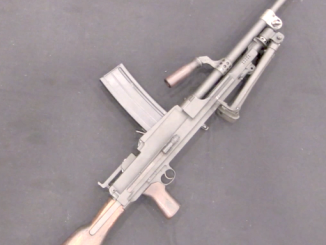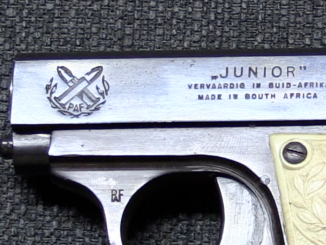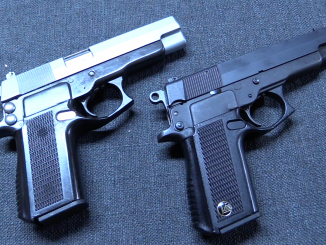Created by noted South African gun designer Tony Neophytou, the NTW-20 is a bolt action anti-material rifle made in 20x82mm, 20x110mm, and 14.5x115mm. The weapon began as idea to use the large quantities of surplus 14.5mm ammunition available at the time, and a recognition that the 14.5mm Soviet cartridge was an excellent anti-armor round, with a really remarkably high muzzle velocity. To widen the rifle’s capabilities, it was decided to incorporate an easily interchangeable barrel, and also chamber it for the 20x82mm round used in the Inkunzi PAW individual weapon and Inkunzi Strike machine gun. The 20x82mm is low velocity compared to traditional 20mm cartridges, carrying the same explosive or incendiary payload but without the punishing recoil of what was originally an aircraft cannon cartridge.
Both of these cartridges are fed from a 3-round box magazine on the left side of the action. A single-shot version in the longer 20x110mm cartridge was also developed by request of a military client, but this cartridge is too long to fit the magazine. A version in .50 BMG was considered, but decided against on the basis of the 14.5mm being just as available and substantially more effective.
The gun is liberally sprinkled with clever engineering and design features – things like using the recoil-absorbing travel of the action to recock the hammer, and the use of both 20mm and 14.5mm cartridge cases as levers for unlocking the barrel. The optic was custom made for the rifle, an 8x56mm long eye relief scope to prevent any chance of the scope bell injuring the shooter during recoil. The trigger mechanism uses only a single spring, and is easily removed from the action. The bolt handle itself is on a pivot pin, and provides the primary extraction leverage to ensure easy cycling with the high-pressure 14.5mm cartridge.
From a military perspective, the NTW-20 is easily broken apart into barrel and action loads, and can be transported more easily than any comparable weapon by a two-man team. The use of a recoil buffer in the action and an effective muzzle brake makes it a remarkably pleasant 20mm rifle to fire. Of all the anti-material rifles I have fired (Lahti L39, Solothurn S18-1000, Mauser T-Gewehr), the NTW-20 was by far the most comfortable to shoot. It was also the only one in which I jumped at the chance to fire more rounds once the filming needs were met. It certainly has a kick, but not at all a painful one.
Many thanks to Denel Land Systems for allowing me to try out this very cool rifle!




” chamber it for the 20x82mm round used in the Inkunzi PAW individual weapon and Inkunzi Strike machine gun. The 20x82mm is low velocity compared to traditional 20mm cartridges, carrying the same explosive or incendiary payload but without the punishing recoil of what was originally an aircraft cannon cartridge.”
According to my knowledge PAW actually use 20 x 42 mm cartridge, while 20 x 82 mm is cartridge which was used in MG 151/20 – German aviation auto-cannon made during 2nd World War by Mauser, cartridge itself is child of 15 x 96 mm and compared to that parent cartridge might be considered low-velocity, but when compared to other WW2-era aviation 20 mm weapon it would be “middle” in terms of muzzle velocity, giving higher value that Oerlikon FF, but lower than Hispano-Suiza HS.404.
If I am not mistaken some ex-German MG 151/20 were used by French forces in late 1940s, though I hope somebody with better knowledge of weapons deployed by French forces in 1940s, could prove or deny it.
“while 20 x 82 mm is cartridge which was used in MG 151/20 – German aviation auto-cannon made during 2nd World War”
——————–
I read same information some time back. Thus Denel did not have to start with clean slate which is often the case.
The MG 151/20 lives on, in mildly modified form, as the Vektor (now Denel) GA-1. South Africa acquired the drawings for the gun from France, which made considerable use of the Mauser post-WW2 (especially fitted to helicopters).
” Thus Denel did not have to start with clean slate which is often the case.”
Well, choice of 20 mm caliber (diameter) was popular through history for light auto-cannons, with many various cartridge designed for that purpose, see:
https://naboje.org/taxonomy/term/1529
(most, but not all were made for that purpose)
Note that first 20 mm auto-cannons were used in combat yet back during Great War, over 100 years ago: http://www.landships.info/landships/artillery_articles/TAK_Becker.html
So you would probably have to very specific requirements to be unable to find fitting cartridge of 20 mm caliber already being in existence.
Neophytou strikes again? His name may not be as well known as Old John Moses, but he is clearly cut from the same cloth.
(Hey, maybe S&W should hire him, to redesign a new light rifle, perhaps?)
The Inkunzi PAW is breathtakingly forward thinking in design and execution. The fact that he can create multi-calibre tools that do big jobs is case in point. There’s a very solid reasoning behind wanting to give organic infantry arms that have massive punch, combined with versatility and actual real world portability.
Not to mention recoil reduction.
Let’s see, largest useful payload, plus lightest functional weight, minus the recoil, carry the 1, equals something along the lines of utilitarian genius. Greatest possible effect in the smallest possible package…
“version in .50 BMG was considered, but decided against on the basis of the 14.5mm being just as available and substantially more effective.”
There I must note that in Soviet Union, not new weapon for that cartridge was in development since Vladimirov’s machine gun and all widely used in Soviet Union are variants of that weapon. Production of basic version was ended yet in 1967, in effect only available version become tank and that version was used in ЗГУ-1 (AA mount)
https://ru.wikipedia.org/wiki/%D0%97%D0%93%D0%A3-1
Generally it looks that advantages of 14,5 x 114 over 12,7 x 108 were not considered to compensate bigger mass.
Yet PTRS and PTRD continue to be used in the region even to this day (obviously because KPV is so prevalent, but still)
As many other older patterns of weapons, if newer weapons filling given role are not available.
“PTRD”
I have doubts about availability of sniper (so called match-grade) cartridges 14,5 x 114. No-one required sniping abilities from PTRD – in fact standard Soviet check procedure for that weapon is to fire 4 cartridges against target of 22 cm diameter at distance of 100 m, then if 3 or more hits were scored, test was passed.
Later main way of usage was in Vladimirov’s machine gun. Making sniper ultra-small-spread and expensive cartridge make little sense, if you would only use it for machine guns.
Anyway I must note 14,5 x 114 spawned 23 x 115 cartridge, which was quite popular in Soviet Air Forces and is fired by following auto-cannons: NS-23, NR-23, AM-23, GSh-23.
These were used both as fixed forward firing weapons of fighters and defensive (turret-mounted) weapons of bomber and transport aeroplanes.
In fact some early-Cold War Soviet jet fighters have armament consisting entirely of auto-cannons firing 23 x 115. For example Lavochkin La-15 (Fantail in NATO parlance) was sporting 3 x NR-23 and Yakovlev Yak-23 (Flora) 2 x NR-23. In role of fighters fixed armament it was relatively soon supplemented/superseded by 30 mm auto-cannons, but as part of defensive armament it had long life.
“(…)20x110mm(…)”
Wait, but which 20 x 110, as there existed at least 3 different cartridge with such designation: http://cartridgecollectors.org/cmo/cmo10apr.htm
“Lahti L39”
This weapon fire 20 x 138 B cartridge, which is very powerful (by 1930s AT rifles standards), but I do not know how to compare it to NTW-20 due to point above.
Also I did not have data for 20 x 138 B as used by Finland, but I can give following data for 20 x 138 B as used by Heer in 2 cm Flak 30. Following data are from: Альбом конструкций патронов стрелкового оружия
20 mm cannon pattern 1930 (“Rheinmetall”) 128 g projectile
Length of rifled part of barrel: 1158,3 mm
Length of travel of projectile: 1175 mm
Traveled distance – velocity:
100 mm – ~ 300 m/s
200 mm – ~ 450 m/s
300 mm – ~ 550 m/s
400 mm – ~ 625 m/s
500 mm – ~ 700 m/s
600 mm – ~ 725 m/s
700 mm – ~ 750 m/s
800 mm – ~ 800 m/s
900 mm – ~ 825 m/s
1000 mm – ~ 850 m/s
1175 mm – ~ 875 m/s
(values read from chart so approximate)
However BEWARE THAT ARE VALUES FOR GERMAN 2 CM FLAK 30 and Finnish 20×138 B might show different performance values.
The 20 x 110 round used is the type developed for the Hispano-Suiza HS 404 in the late 1930s.
Crikey. Serious point, Ian. Indoors, with that thing? Surely you need plugs and muffs? I wouldn’t want you suffering unnecessary hearing damage (says 50 year-old guy who has).
This needs to be cross-bred with a GM6 Lynx, badly.
Damper, not dampener.
One inhibits, one gets wet.
A comfortable anti-material rifle? That’s nearly impossible to craft, but now I’ve seen the proof that such a thing exists!
The comment that the gun is more comfortable to fire than Lahti, solothurn etc
Is comparing apples and oranges, there’s a huge difference in the case capacity and powder loading of those Aircraft cannon chambered anti tank rifles and this rifle.
A rifle firing .300 rook would likely be a more comfortable .30 calibre rifle to fire than a rifle firing one of the .416 rigby based .300 super mags
But that doesn’t tell us anything about the effectiveness of the measures that the designer took to reduce the felt recoil
I’m glad Ian finds the recoil on that thing so enjoyable. I liked the part where, after one shot, he appeared to pause, gather his senses, and then remember where the bolt handle was. I grew up testing loads off the bench (we considered MOA a starting-point, not a goal), and I long ago had it with being belted by high-power rifles — rifles far less potent than that monster. However, I think that in actual combat, with adrenaline flowing and the air full of unpleasant enemy missiles, the recoil might go essentially unnoticed. But your muzzle signature would be another matter. I have to wonder if you’d even try to get off 3 rds before shifting position.
The primary use for the thing is to shoot up oncoming vehicles at a road-block. Maybe another possible use was for ambush or infiltration & destruction of material, but light anti-material guns seem to get the most use in defensive stances, anymore. Air assault or mortar/artillery would generally be used to take out stuff you already know about that’s located in enemy territory (unless you simply can’t tolerate any collateral damage at all, I guess)
Is it just coincidence that a second arms baker in South Africa, Truvelo, is also offering anti material rifles in 20mm, yet with a distinctively different arms design?
(By the way, the Truvelo Raptor might be one of the most forgotten modern assault weapons )
The Truvelo Raptor is based on the Russian AK series, so there’s a very low chance that it will be forgotten in the foreseeable future.
The Truvelo also uses the same 20 x 110 HS ammunition as the NTW 20.
Wikipedia’s version of the ammo story:
“The 20×42 mm cartridge was specifically developed for the PAW-20 by Denel PMP, decreasing the overall weight and size of the weapon, and enabling it to hold more rounds in the magazine.[clarification needed] It has a muzzle velocity of 310 m/s (1,000 ft/s)”
The PAW-20 is identified as becoming the Inkunzi PAW. Thus Denel markets all the weapons mentioned in this article, all using this same round. The 1000 fps muzzle velocity is the clincher – that’s no velocity for anti-aircraft use.
It makes me wonder why Denel didn’t just use the necked up 14.5 using a 23mm projectile using exactly the same parent cartridge dimensions. Slightly higher payload and wider availability of munitions (especially in soviet supplied military states) when compared to the 20×82 which apart from south african auto cannons seems to be not in use since employed by the Luftwaffe in the 1940’s